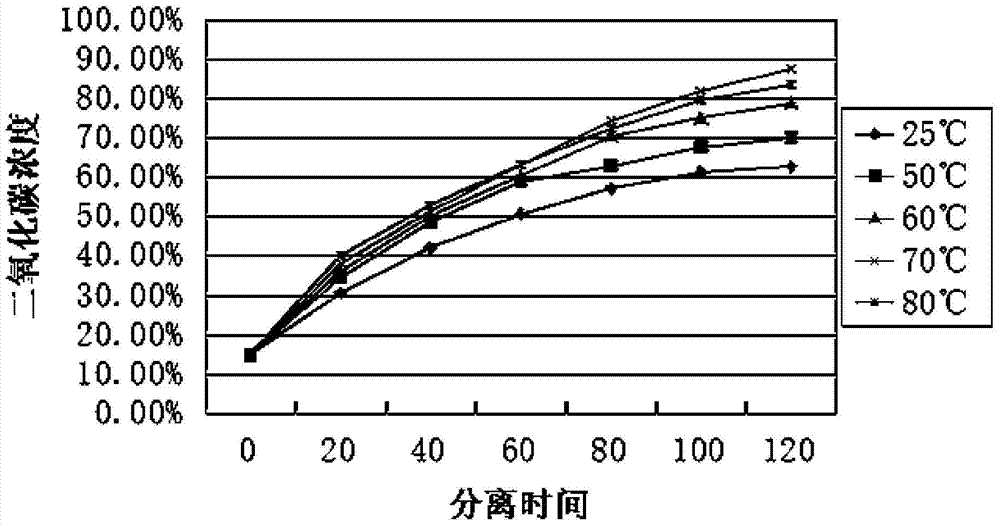Environmentally friendly liquid-supported carbon dioxide separation membrane
A carbon dioxide and separation membrane technology, applied in separation methods, semi-permeable membrane separation, dispersed particle separation, etc., can solve the problem of low selectivity, and achieve the effects of low preparation cost, low price and high stability
- Summary
- Abstract
- Description
- Claims
- Application Information
AI Technical Summary
Problems solved by technology
Method used
Image
Examples
Embodiment 1
[0040] The main components of the environmentally friendly liquid-supported carbon dioxide separation membrane prepared in this example are polyethylene polyamine and polyvinyl alcohol, and the preparation method is as follows:
[0041] Step 1: Take 5g of polyethylene polyamine and 20g of polyvinyl alcohol as the main solute of the separation membrane.
[0042] Step 2: Take 225g of water as a solvent, heat it to 90°C, add polyvinyl alcohol and polyethylene polyamine successively, stir and dissolve, and form a separation membrane casting solution.
[0043] Step 3: Pour the solution evenly on the substrate, and scrape it into a 200 μm wet film with a film scraper.
[0044] Step 4: Put the substrate into a 120° C. constant-temperature drying oven for 3 hours of heat treatment.
[0045] Step 5: Take out the substrate, and after it cools down, remove the film from the substrate, that is, a film with a mass ratio of polyethylene polyamine to polyvinyl alcohol of 1:4 and a thickness...
Embodiment 2
[0047] The main components of the environmentally friendly liquid-supported carbon dioxide separation membrane prepared in this example are polyethylene polyamine and polyvinyl alcohol, and the preparation method is as follows:
[0048] Step 1: Take 5g of polyethylene polyamine and 10g of polyvinyl alcohol as the main solute of the separation membrane.
[0049] Step 2: Take 35g of water as a solvent, heat it to 95°C, add polyvinyl alcohol and polyethylene polyamine successively, stir and dissolve, and form a separation membrane casting solution.
[0050] Step 3: Pour the solution evenly on the substrate, and scrape it into a 40 μm wet film with a film scraper.
[0051] Step 4: Put the substrate into a constant temperature drying oven at 80° C. for 5 hours of heat treatment.
[0052] Step 5: Take out the substrate, and after it cools down, remove the film from the substrate, that is, a film with a mass ratio of polyvinyl polyamine to polyvinyl alcohol of 1:2 and a thickness of...
Embodiment 3
[0054] The main components of the environmentally friendly liquid-supported carbon dioxide separation membrane prepared in this example are polyethylene polyamine and polyvinyl alcohol, and the preparation method is as follows:
[0055] Step 1: Take 5g of polyethylene polyamine and 15g of polyvinyl alcohol as the main solute of the separation membrane.
[0056] Step 2: Take 100 g of water as a solvent, heat it to 93° C., add polyvinyl alcohol and polyethylene polyamine successively, stir and dissolve, and form a separation membrane casting solution.
[0057] Step 3: Pour the solution evenly on the substrate, and scrape it into a 160 μm wet film with a film scraper.
[0058] Step 4: Put the substrate into a constant temperature drying oven at 100° C. for 3 hours of heat treatment.
[0059] Step 5: Take out the substrate, and after it cools down, remove the film from the substrate, that is, a film with a thickness of 33 μm and a mass ratio of polyethylene polyamine to polyvinyl...
PUM
| Property | Measurement | Unit |
|---|---|---|
| thickness | aaaaa | aaaaa |
| boiling point | aaaaa | aaaaa |
Abstract
Description
Claims
Application Information
 Login to View More
Login to View More - R&D
- Intellectual Property
- Life Sciences
- Materials
- Tech Scout
- Unparalleled Data Quality
- Higher Quality Content
- 60% Fewer Hallucinations
Browse by: Latest US Patents, China's latest patents, Technical Efficacy Thesaurus, Application Domain, Technology Topic, Popular Technical Reports.
© 2025 PatSnap. All rights reserved.Legal|Privacy policy|Modern Slavery Act Transparency Statement|Sitemap|About US| Contact US: help@patsnap.com



